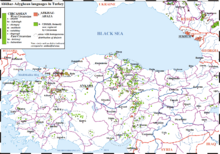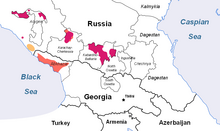Circassian languages
| Circassian (adəgăbză) | ||
|---|---|---|
|
Spoken in |
Turkey, Russia | |
| speaker | about 1.5 million | |
| Linguistic classification |
|
|
| Official status | ||
| Official language in |
|
|
| Language codes | ||
| ISO 639 -2 |
kbd; ady |
|
The group of Circassian languages consists of two dialect groups, which are spoken by the various Circassian tribes and from which written languages were developed only in the 20th century: the West or Lower Circassian dialects with the written language Adygean and the East or Upper Circassian dialects with the written language Kabardian . East Circassian probably changed between the 13th and 14th centuries. Developed away from the common Circassian language in the 19th century.
Together with Abkhazian , Abasinian and Ubychian , they belong to the Northwest Caucasian language family.
Since the expulsions at the end of the Caucasus War in the 19th century , most Circassian speakers no longer live in the Western Caucasus, which belongs to the Russian Federation, but more in the successor states of the Ottoman Empire in the Middle East and on the Balkan Peninsula, most of them in Turkey , where they are received Circassian especially in some villages.
Dialects and written languages

In the West Caucasus, which belongs to Russia, Caucasiologists still differentiate between four West or Lower Cherkess dialects, which are named after traditional Circassian tribes : Temirgojisch (also called Chemguy / Chemguy ), Abadsech (also Absach ), Bschedugh and Schapsugisch . In addition, the dialects Natchuajisch (also Natuchajisch) , Machoshisch and Hatkuajisch appear exclusively in the Diaspora . Some Kaukasiologists classify the only sporadically spoken dialect Hakutschisch in villages near Tuapse , which others see as a Schapsug subdialect, named after a historical Circassian tribe that later joined the Schapsugen tribe . The West Cherkessian written language Adygean was developed in the early Soviet period on the basis of the Temirgoj dialect, which is spoken by the Temirgojern and some neighboring tribes.
The somewhat closer Eastern or Obertscherkessisch is sometimes still in the central Cabardian dialect of the region "Great Kabarda", the Eastern Cabardian dialect of the "Little Kabarda" around Mozdok and the upper reaches of the Terek , the Western Cabardian dialect at the upper and middle Kuban and the dialect Beslenejisch , named after the traditional Circassian tribe of the Beslenejer (the last two in Karachay-Cherkessia ). The central Kabardian dialect of the Great Kabarda is the basis of the written language Kabardian .
Linguistic situation
Adygean is the official language in the Republic of Adygea , while Kabardian is in Kabardino-Balkaria and Karachay-Cherkessia . All three are autonomous republics within the Russian Federation . Circassian is also spoken in Turkey and in some other countries in the Middle East and the Balkans (around 1.5 million speakers in total).
Since East Circassian has fewer sounds than West Circassian, it is more difficult for East Circassian speakers to understand West Circassian, but the reverse is easier.
In Circassian itself, both written languages and dialect groups are usually only unspecifically referred to as Adygej (адыгэбзэ / адыгабзэ, both pronounced: adəgăbză and literally translated "Circassian language"). The terminological division into Kabardian (East Cherkessian) and Adygejisch (West Cherkessian) is established in Russian and other foreign languages, but is only transferred to Circassian in exceptional cases.
font
The Circassians did not have their own written language. Since Islamization they used the Arabic language as a written language. At the beginning of the 20th century, the Latin alphabet was used to write Circassian dialects. Since 1937/38 the Cyrillic alphabet has been used with some modifications. Each of the two languages (Adygean and Kabardian) uses its own Cyrillic alphabet, both of which have been increasingly adopted in the diaspora since the opening of the Soviet Union.
Linguistic characteristics
The Circassian languages are agglutinating languages .
literature
- Monika Höhlig: Contact-related language change in the Adygeic colloquial language in the Caucasus and Turkey . LINCOM Europe, Munich 1997 ISBN 3-89586-083-2
- Georgij A. Klimov: Introduction to Caucasian Linguistics. Hamburg 1994, pp. 47-87.
Web links
- Circassian Cultural Association V. Cologne
- Newspaper of the Kabardino-Balkarian Republic
- Adyghe . Ethnologue , Languages of the World
- Kabardian . Ethnologue , Languages of the World
Individual evidence
- ↑ The explanation of the letters h and k was forgotten in the legend. But a comparison with the original, complete map by the same authors with all three language families of the Caucasian languages in Turkey on the Lingvarium page of Moscow's Lomonosov University shows that k is Kabardian and h is Hatkuajian.
- ↑ Klimov, pp. 48-49
- ↑ Klimov, pp. 48-49


